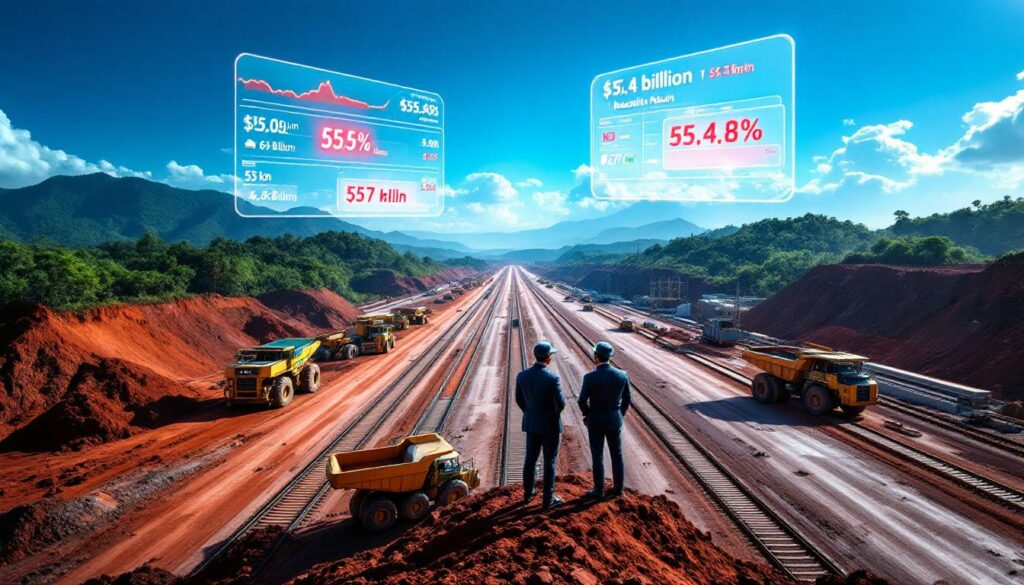Vale's Ongoing Assessment of the Bamin Project: Economics Not Adding Up
Vale SA continues its thorough analysis of a potential investment in Eurasian Resources Group's (ERG) Brazilian iron ore project, known as Bahia Mineração (Bamin). However, significant financial viability concerns remain at the forefront of the decision-making process. According to Vale's Chief Financial Officer Marcelo Bacci, the economics of the project are "still not adding up" despite ongoing consideration.
"The volume of ore available there alone does not justify the construction of the infrastructure that is needed in terms of railways," Bacci stated in a recent interview. "We still haven't been able to come up with an equation that makes this calculation work."
The infrastructure cost challenge is substantial, with an estimated 30 billion reais ($5.4 billion) investment required for mine expansion, port construction, and completion of a critical 527-kilometer (327-mile) railway stretch. Despite these challenges, the production potential remains significant, with the Bamin project expected to yield up to 26 million tons of iron ore annually when fully operational.
Why Is Vale Hesitant About the Investment?
Infrastructure Cost-to-Benefit Ratio
The primary hesitation for Vale centers around the substantial infrastructure investment required relative to the expected return. The CFO has been explicit that the "volume of ore available alone does not justify the construction of the infrastructure" – highlighting a fundamental imbalance in the project economics.
The transportation infrastructure gap presents a particularly challenging obstacle. Completing the 527-kilometer railway stretch represents a significant portion of the overall investment, creating a capital efficiency concern that Vale has thus far been unable to resolve.
As Bacci noted, the company has been unable to "come up with an equation that makes this calculation work," suggesting that traditional return-on-investment metrics are not being met under current project parameters.
Industry analysts point out that this situation reflects a common challenge in mining infrastructure development: the need to balance upfront capital expenditure against long-term production capacity. In this case, the 26 million ton annual production potential appears insufficient to justify the massive infrastructure outlay when evaluated in isolation.
Alternative Cargo Requirement
One potential solution identified by Vale would be to develop additional revenue streams beyond iron ore transportation. Making the project financially viable would depend significantly on finding ways to transport cargo other than just iron ore along the proposed railway corridor.
This multi-use infrastructure approach has been successfully implemented in other mining regions globally, where railways built primarily for mineral transportation also serve agricultural, industrial, or passenger needs, thereby distributing the infrastructure cost across multiple revenue streams.
Partnership Requirements
Vale has clearly stated that it would only enter the project alongside other partners, indicating a strategic preference for risk-sharing in such a capital-intensive venture. This approach reflects a growing trend in the mining industry toward collaborative development of major infrastructure projects.
Brazil's federal government has been actively trying to facilitate a deal that includes Vale, recognizing the project's potential to help develop infrastructure in an economically important region. This government involvement underscores the project's strategic importance beyond pure commercial considerations.
The focus on regional development creates a complex multi-stakeholder environment where public benefits must be balanced against private investment returns. A sophisticated financing structure would likely be required to distribute the investment burden among various partners, potentially including government entities, private corporations, and financial institutions.
How Does This Project Fit Into Brazil's Mining Infrastructure Development?
Strategic Importance of the Bamin Project
The Bamin project represents more than just an iron ore mine; it embodies a significant opportunity for regional infrastructure development in Brazil. The proposed railway and port facilities would enhance transportation networks in previously underserved areas, potentially stimulating broader economic growth.
From a national perspective, the development would enhance Brazil's iron ore export capacity, reinforcing the country's position as a global supplier. The additional 26 million tons of annual production would contribute to Brazil's mining sector, which remains a critical component of the national economy.
The transportation network expansion through railway completion would strengthen the country's logistics infrastructure, addressing a persistent challenge in Brazilian commodity exports. Well-developed logistics networks are essential for maintaining cost competitiveness in global markets, particularly for bulk commodities like iron ore price trends where transportation represents a significant portion of delivered costs.
The project also presents a significant public-private partnership opportunity, with the government's facilitation efforts indicating its recognition of the national strategic importance. Such partnerships have become increasingly common in Brazil's infrastructure development landscape as a means to mobilize capital while balancing public and private interests.
Required Infrastructure Components
The comprehensive infrastructure requirements for the Bamin project include three major components that must be developed in concert:
-
Railway development: The 527-kilometer railway stretch represents the most capital-intensive infrastructure element and the primary obstacle to project viability. This railway would connect the mine to coastal export facilities.
-
Port construction: New export facilities would be required to handle the additional 26 million tons of annual production, representing another significant capital expenditure component.
-
Mine expansion: The existing mining operations would need substantial scaling to reach their full production potential of 26 million tons annually.
-
Logistics integration: Beyond the physical infrastructure, the project requires sophisticated logistics integration to connect mine, rail, and port operations efficiently. This integration is critical for optimizing the end-to-end supply chain and maximizing operational efficiency.
What Are the Financial Considerations for This Project?
Investment Requirements and Challenges
The total project cost estimate of 30 billion reais ($5.4 billion) represents a substantial capital commitment that would require careful financial structuring. This investment encompasses the complete development package including mine expansion, railway completion, and port construction.
Capital allocation efficiency remains at the heart of Vale's hesitation. As a publicly traded company with global operations, Vale must evaluate this potential investment against alternative uses of capital within its portfolio. The company's questioning of the return on investment potential reflects standard corporate finance discipline rather than specific concerns about the Bamin project itself.
The high infrastructure-to-production ratio presents a particular challenge. With $5.4 billion in infrastructure investment supporting 26 million tons of annual production, the per-ton capital intensity exceeds typical benchmarks for established iron ore operations. This ratio is particularly challenging in a commodity business where price volatility can significantly impact investment returns.
Potential Solutions to Make the Project Viable
Several approaches could potentially improve the project's financial viability:
-
Diversified cargo strategy: As identified by Vale, finding additional freight beyond iron ore represents a critical path to enhancing revenue streams and distributing infrastructure costs across multiple users.
-
Multi-partner investment structure: Distributing capital requirements among several stakeholders could reduce the financial burden on any single participant while creating aligned interests in the project's success.
-
Government incentives: Public sector support through tax incentives, subsidized financing, or direct investment could enhance financial viability, particularly given the project's regional development benefits.
-
Phased development approach: A staged implementation plan could manage capital outlays more effectively by aligning infrastructure development with production ramp-up, potentially improving project economics through better capital efficiency.
Financial disclaimer: Mining infrastructure investments involve significant risks including cost overruns, construction delays, commodity price volatility, and operational challenges. Any investment decisions should be based on comprehensive due diligence and professional financial advice.
How Does This Situation Compare to Other Mining Projects?
Market Context for Iron Ore Investments
Global iron ore forecast considerations inevitably influence investment decisions of this magnitude. With iron ore prices historically volatile, long-term price assumptions play a critical role in determining project viability. Any infrastructure investment must be justified against conservative price scenarios to ensure resilience through market cycles.
The Bamin project faces competition from established operations with mature infrastructure. Major iron ore producers in Brazil and Australia operate with significantly lower infrastructure costs per ton, having amortized their initial capital investments over decades of production.
This infrastructure advantage gap creates a significant hurdle for new developments. Established mines often benefit from superior logistics networks that were developed during periods of lower construction costs or with government support that may not be available today.
Capital efficiency benchmarks within the mining industry have generally tightened in recent years. Shareholders increasingly demand disciplined capital allocation with clear pathways to returns, making it more challenging to justify infrastructure-heavy investments, particularly in the current economic climate.
Industry Trends in Mining Infrastructure Development
Several broader industry trends provide context for Vale's hesitation:
-
Increasing infrastructure costs: Global inflation in construction materials and labor has driven up expenses for major development projects, challenging traditional investment models.
-
Partnership models evolution: The growing trend toward multi-stakeholder approaches reflects recognition that single-company development of major infrastructure projects often faces prohibitive capital requirements.
-
Government involvement patterns: Increasing public sector facilitation in strategic projects has become more common, particularly where projects deliver broader economic benefits beyond the mine itself.
-
Logistics-focused investment criteria: Greater emphasis on transportation efficiency has emerged as companies recognize that logistics costs often determine competitive positioning in global commodity markets.
What's Next for the Bamin Project?
Potential Outcomes and Decision Timeline
The path forward for the Bamin project involves several potential scenarios:
-
Continued negotiations: Discussions are ongoing between Vale, ERG, and the Brazilian government to explore restructured approaches that might improve project economics.
-
Alternative partner exploration: If Vale ultimately declines participation, ERG may intensify efforts to attract other mining companies or infrastructure investors to the project.
-
Revised economic models: Efforts to improve financial viability through structural adjustments could include expanded cargo scope, government subsidies, or innovative financing mechanisms.
-
Decision factors to watch: Several external variables could influence the project's trajectory, including:
- Iron ore price movements
- Infrastructure cost developments
- Partnership formation opportunities
- Brazilian government policy changes
- Global capital market conditions
No specific timeline for Vale's final decision has been publicly disclosed, though the continued evaluation suggests active consideration rather than indefinite delay.
Competitive Interest in the Project
The Bamin project has attracted attention beyond Vale. According to industry reports from Mining.com, Brazil Iron has reportedly made a $1 billion offer for the project, indicating recognition of underlying value despite the infrastructure challenges.
This competitive interest highlights the strategic value assessment differences among potential investors. Companies may assign different values to the asset based on their existing operations, infrastructure synergies, or long-term strategic objectives in the region.
The project represents potential regional integration possibilities that could create consolidation opportunities within Brazil's mining sector. Companies with complementary assets might identify synergies that improve the overall economics beyond what Vale has calculated.
First-mover advantage considerations also play a role in competitive dynamics. Early entrants into developing mining regions often secure preferential terms with governments and communities, potentially offsetting some of the infrastructure development costs through favorable regulatory treatment.
FAQ: Vale and ERG Brazil Mine Investment
What is the Bamin project?
Bahia Mineração (Bamin) is an iron ore mining project in Brazil owned by Eurasian Resources Group (ERG). The project requires significant investment to reach its full production capacity of 26 million tons annually. The development encompasses mine expansion, railway construction, and port facilities.
How much investment does the Bamin project need?
The project requires an estimated 30 billion reais ($5.4 billion) to expand mining operations, build port facilities, and complete a 527-kilometer railway stretch. This substantial capital requirement represents the primary challenge to project viability.
Why is Vale hesitant about investing in the project?
Vale's CFO has explicitly stated that the volume of available ore alone doesn't justify the massive infrastructure investment required, particularly the railway construction costs. The company has been unable to develop a financial model that delivers acceptable returns given the current project parameters.
What would make the project financially viable?
According to Vale, finding ways to transport cargo beyond just iron ore would be essential to improve the project's economics and justify the infrastructure investment. Additional approaches might include government support, mining joint ventures, or phased development strategies.
Is Vale the only potential investor in the project?
No, Vale has stated it would only enter the project alongside other partners, and reports indicate Brazil Iron has made a $1 billion offer for the project. The Brazilian government is also actively involved in facilitating potential investment structures that could include multiple participants.
Note: This article contains forward-looking statements about potential mining developments. Such statements involve inherent risks and uncertainties. Actual outcomes may differ materially from those projected due to factors including commodity price fluctuations, regulatory changes, construction challenges, and iron ore demand insights and market conditions.
As BHP pivot strategy decisions have shown in recent years, major miners are increasingly selective about infrastructure-intensive projects, preferring those with clearer return-on-investment profiles and more manageable upfront capital requirements.
Looking for Early Warnings on the Next Mining Discovery?
Stay ahead of the market with Discovery Alert's proprietary Discovery IQ model, which instantly notifies investors of significant ASX mineral discoveries, turning complex data into actionable insights. Explore why major mineral discoveries can lead to substantial returns by visiting Discovery Alert's dedicated discoveries page and start your 30-day free trial today.




